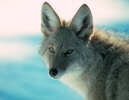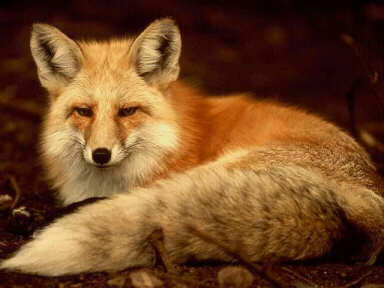


 Introduction:
Introduction:Foxes are amongst the most widely known of all the world´s animals, having been firmly entrenched in human culture ever since mankind first told stories about animals. Perhaps lacking the majesty of either the lion or the wolf, the fox has nevertheless achieved a familiarity with us that is inconsistent with what at first seems to be such an unremarkable animal. They were at once despised or even feared for their rivalry with early man, while admired for their beauty and craftiness.
Our familiarity with these animals can be explained quite simply. In terms of their ability to coexist with humans, their wide geographical range, and their sheer numbers, foxes are the most successful of all the major four legged predators. No other large carnivore even comes close.
   |
| Relatives of the fox include the wolf, the coyote, and Nikki. |
Like domestic dogs, wolves, and coyotes, foxes belong to the family Canidae, and like these relatives had originally belonged to the genus Canis. They have more recently been reclassified, as more has become known about them (their taxonomic classification is frequently revised). Some twenty-two species of foxes are now grouped into at least nine genera, although there is still scientific disagreement on the matter. The largest and best known genus is, of course, Vulpes. Named for the Latin word for fox, this group not only contains the famous red fox, but also the swift and kit foxes, and a majority of the other species. Alopex, Atelocynus, Cerdocyon, Fennecus, Dusicyon, Otocyon, Pseudalopex and Urocyon round out the remaining genera. There is currently some debate as to whether some of these genera, such as Alopex and Fennecus, should be incorporated into Vulpes; species within these genera are sometimes referred to as vulpine foxes.
These distinctions from the rest of the dog family were made because of certain differences between foxes and other canids. To take Vulpes as an example, the original criteria for differentiating between the two was cranial structure; there´s a big enough difference between the sinus cavities of the two groups to warrant a separation between them.
Regardless of any differences between foxes and dogs, they share several traits due to their common ancestry. Their basic body structures are the same. From a distance, it is often easy to mistake one for the other. Closer inspection of a fox reveals an animal that is smaller, lighter, and more graceful- almost catlike, right down to their semi-retractable claws and elliptical pupils. Dogs and cats had their last common ancestors forty million years ago in animals known as Miacidae. It was not until after canines and felines split off from one another that foxes and dogs went their separate ways. So how does a doglike fox come to resemble a cat?
The short answer lies in the fact that foxes and cats made their livings in a similar way. Millions of years ago, foxes started to specialize in the independent, nocturnal hunting of small prey, and evolution took over. This is the same ecological niche occupied by cats. If an animal is successful in a certain role, it passes its genes on to it´s offspring. The most successful of the offspring pass their genes on and so on. Cats that became better at seeing in the dark hunted more effectively and lived to produced more offspring, and so their elliptical pupils and light sensitive eyes evolved. Foxes that became better at seeing in the dark also lived to produced more offspring and so their eyes evolved along similar lines. Several traits related to how cats and there vulpine cousins adapted to the same niche were similarly affected: specialized eyes to see in the dark; sensitive whiskers; light, agile bodies; long tails that improve balance. Neither animal shared any genetic information leading up to their current development, but similar life styles resulted in similar anatomies. This convergent evolution is quite common in nature. Many other unrelated animals have evolved similar characteristics. Examples include fish and whales, birds and bats, and penguins and seals.
Foxes have inherited some of the most useful adaptations of both the dog and cat worlds. These evolutionary gifts have given them the ability to survive and even flourish in the face of whatever nature and mankind have thrown at them. Foxes are native to five of the seven continents, and their nineteenth century introduction to Australia has proven a disastrous success. From arctic tundra to desert grasslands, from the prairies and steppes to boreal and tropical forests, they can inhabit virtually any environment humans can.
| Table of Contents |